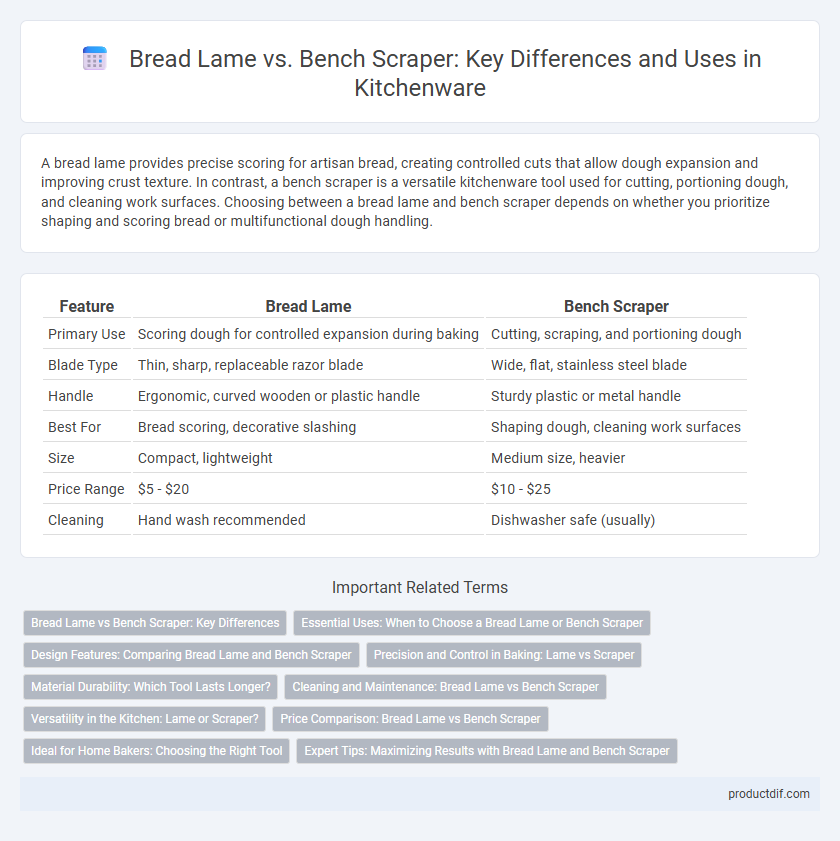A bread lame provides precise scoring for artisan bread, creating controlled cuts that allow dough expansion and improving crust texture. In contrast, a bench scraper is a versatile kitchenware tool used for cutting, portioning dough, and cleaning work surfaces. Choosing between a bread lame and bench scraper depends on whether you prioritize shaping and scoring bread or multifunctional dough handling.
Table of Comparison
| Feature | Bread Lame | Bench Scraper |
|---|---|---|
| Primary Use | Scoring dough for controlled expansion during baking | Cutting, scraping, and portioning dough |
| Blade Type | Thin, sharp, replaceable razor blade | Wide, flat, stainless steel blade |
| Handle | Ergonomic, curved wooden or plastic handle | Sturdy plastic or metal handle |
| Best For | Bread scoring, decorative slashing | Shaping dough, cleaning work surfaces |
| Size | Compact, lightweight | Medium size, heavier |
| Price Range | $5 - $20 | $10 - $25 |
| Cleaning | Hand wash recommended | Dishwasher safe (usually) |
Bread Lame vs Bench Scraper: Key Differences
A bread lame features a sharp, replaceable blade designed for scoring dough to control expansion during baking, while a bench scraper is a flat, rigid tool primarily used for cutting, dividing, and transferring dough. The bread lame provides precision cuts that enhance crust texture and appearance, whereas the bench scraper offers versatility in handling dough and cleaning work surfaces. Understanding these key differences helps bakers choose the right tool for specific bread-making tasks.
Essential Uses: When to Choose a Bread Lame or Bench Scraper
A bread lame is essential for scoring dough to control expansion and create decorative patterns on bread crusts, ensuring precise cuts that enhance both appearance and texture. A bench scraper excels in dividing dough, transferring chopped ingredients, and cleaning work surfaces, providing versatility and efficiency in the kitchen. Choosing between the two depends on whether precision cutting or versatile dough handling is the priority in bread preparation.
Design Features: Comparing Bread Lame and Bench Scraper
The bread lame features a slender, ergonomic handle with a sharp, replaceable razor blade designed for precise scoring of dough surfaces, enhancing oven spring and crust texture. In contrast, the bench scraper boasts a broad, flat stainless steel blade with a sturdy handle, optimized for cutting, scraping, and transferring dough efficiently on work surfaces. Both tools prioritize durability and comfort, but their design reflects distinct functions in bread preparation and dough handling.
Precision and Control in Baking: Lame vs Scraper
A bread lame offers exceptional precision and control for scoring dough, allowing bakers to create intricate patterns and direct the expansion of bread during baking. In contrast, a bench scraper excels in controlling dough portions and shaping but lacks the fine scoring capabilities needed for detailed cuts. For achieving perfect crust development through precise incision, the bread lame is an essential tool, while the bench scraper serves better in general dough handling and cleanup.
Material Durability: Which Tool Lasts Longer?
Bread lames are typically crafted with stainless steel blades and wooden or plastic handles, offering sharpness and precision but are prone to blade dulling and handle wear over time. Bench scrapers feature sturdy stainless steel or carbon steel blades with durable plastic or metal handles, designed to withstand heavy-duty scraping and dough manipulation without significant wear. Overall, bench scrapers generally have superior material durability, making them longer-lasting tools in kitchenware compared to bread lames.
Cleaning and Maintenance: Bread Lame vs Bench Scraper
Bread lames feature thin, sharp blades that require gentle cleaning with a soft brush or cloth to prevent dulling and rust, while bench scrapers, typically made of stainless steel or plastic, can be easily washed with warm soapy water and are dishwasher safe. Maintaining a bread lame involves careful drying and occasional blade replacement to ensure precision cuts, whereas bench scrapers demand minimal upkeep, focusing mainly on removing dough residues to maintain hygiene. Proper cleaning and maintenance extend the durability and performance of both tools, essential for consistent kitchen efficiency.
Versatility in the Kitchen: Lame or Scraper?
A bread lame is specifically designed for scoring dough with precision, enhancing bread crust texture and expansion during baking. A bench scraper offers broader versatility, excelling at dough cutting, portioning, and transferring, as well as cleaning work surfaces. Choosing between a bread lame and a bench scraper depends on whether precise scoring or multiple dough-handling tasks are the kitchen priority.
Price Comparison: Bread Lame vs Bench Scraper
A bread lame typically costs between $15 and $35, reflecting its specialized design and sharp, replaceable blades ideal for scoring dough. Bench scrapers, priced around $10 to $20, offer a more versatile tool for dividing dough, scraping surfaces, and handling kitchen tasks, often featuring durable stainless steel construction. Choosing between the two depends on budget and specific baking needs, as the bread lame focuses on precise scoring while the bench scraper provides multifunctional utility at a generally lower price point.
Ideal for Home Bakers: Choosing the Right Tool
A bread lame offers precise scoring for artisan-style loaves, enhancing oven spring and crust texture, making it ideal for home bakers focused on professional-quality bread presentation. Bench scrapers excel at dividing dough, transferring ingredients, and cleaning work surfaces, providing versatile utility in everyday baking tasks. Selecting between a bread lame and a bench scraper depends on the baker's specific needs: scoring finesse versus multi-functional dough handling.
Expert Tips: Maximizing Results with Bread Lame and Bench Scraper
Using a bread lame, expert bakers achieve precise scoring that controls dough expansion and enhances crust texture, while a bench scraper excels in dough portioning and surface cleanup for efficient workflow. Maximizing results involves pairing the sharp blade of the lame for clean cuts with the sturdy bench scraper to handle sticky dough and maintain a tidy workspace. Incorporating both tools streamlines bread-making tasks, ensuring consistent loaf shapes and professional presentation.
Bread Lame vs Bench Scraper Infographic

 productdif.com
productdif.com